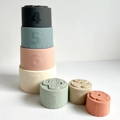From Blocks to Puzzles: Sequential Learning with Montessori Toys
Have you ever watched a kid playing with blocks, arranging shapes, or solving puzzles? Well, there’s much more to it than just mere playing. They are actually learning in a special way.

Sequencing means putting things in order, like building a snowman. First, you gather snow, then roll it into balls, stack them up, and add the finishing touches. Each step leads to the next, creating something awesome!
Throw some Montessori toys for 1 year olds into the mix, and voila, you’ve got yourself a complete learning experience for your kid. So, let’s get to know how Montessori and sequential learning go together. But first, let's start with the basics.
What is a Sequential Learning for Young Children?
What's sequencing, anyway? It's like following a recipe or stacking blocks from the largest to the smallest. You take a big task and break it down into small steps, putting them in the right order.
Let’s demonstrate this in an example.
Imagine making a sandwich. First, you get the bread, then the cheese, then the meat. But what if you put the cheese on first? It might still taste good, but it's not quite right. That's why sequencing is important - it helps us do things in the right order, step by step.

Why is Sequencing Important?
The importance of sequencing is seen early on and later in life. Sequencing helps us tell stories in the right order and understand what's coming next. It's super important for reading, writing, and following instructions, no matter if they're spoken or written down.
Think about it: we all use sequencing every day without even realizing it!
What is an Example of Sequential Teaching?
So, how can you help your child learn sequencing?
- Start Simple: Introduce the idea of sequencing using words like 'first,' 'next,' and 'last. '
- Make it Fun: Show your baby how to do a task in order. For example, use Montessori stacking cups, but stack them by color or by size so there’s order to it.
- Use Visual Aids: Pictures or visuals can make sequencing easier to understand, especially for babies and younger kids.
- Practice Together: Play together, but only in the beginning. The idea is to practice a simple task with your kid and then let them complete it in the exact same order.
- Build Up: Once they're comfortable with three-step sequencing, add more steps and make it a challenge!
The Foundation: Building Blocks
Block play is super important for little ones! It’s all about letting them express their creativity, imagination, and problem-solving skills. Plus, block play helps kids understand basic math concepts, like shapes and sizes.

But did you know that block play has its own developmental sequence? It's kinda like learning to write or draw. For babies, block play is still simple. It’s a pretty big accomplishment if your baby manages to stack more than 3 or 4 blocks together.
And by doing so, they’re actually creating an idea that each block has its place. It might be hard at first, but with a bit of practice and your help, they’ll manage to get it there.
Montessori Building Blocks
Meet the Montessori building blocks, a toy that inspires exploration and creativity through natural materials and a special design. With different colors and shapes, your young one will engage in purposeful play for quite some time.
This toy teaches sequencing skills that prepare your child for school and beyond. These blocks offer hands-on learning, boosting problem-solving and coordination while teaching your child to put things in the right order.
On top of that, these blocks are made from natural wood and are coated in non-toxic paint. In other words, they are safe for your little one, even if they start chewing them.
Bridging the Gap: Shape Sorters and Stacking Rings
Shape sorters and stacking rings are great for your child's fingers and focus. They help with thinking skills and are super fun! Children often find themselves drawn to sorting and stacking toys repeatedly, especially if you show them how to do it properly.

By taking turns building and knocking down towers, they learn that building something requires concentration and skill. On the other hand, sorting toys helps them understand how things fit together and their place in the world. And, the science behind Montessori toys allows children to practice their skills and learn how to sort and stack.
One of the best Montessori toys for stacking activities sure is the:
Montessori Baby Stacking Cups
Let's talk about these awesome stacking cups for babies! First of all, they're helping your baby master motor skills and build those little baby muscles. From the time they start grabbing things to when they're toddlers, these cups are there every step of the way.
What's cool is that they help with both small and big movements, like picking up and stacking cups. And when your baby plays with them, they're learning how to balance and coordinate their movements as well.
Now, here's the best part: these cups also help with problem-solving. Your baby figures out how to stack them in the right order, which is like solving a puzzle. Plus, they're super fun to play with and don't need any screens, just pure, hands-on fun!
Cognitive Challenges: Sequencing Puzzles
Sequencing puzzles are like brain workouts for kids! Some are simple and perfect for babies, while others are better for slightly older kids, such as toddlers and preschoolers.

These puzzles are like storyboards that help kids understand the order of events. They cover a lot of topics as well. From showing how butterflies and frogs grow to everyday things like making a sandwich or using the toilet.
It’s all about finding the one that’s most interesting for your kid. Why don’t you try out these:
Montessori Happy Puzzles
Did you know puzzles can teach kids about sequencing? When kids play with Montessori Happy Puzzles, they're actually learning the order of steps needed to solve a problem.
Starting early with puzzles helps kids understand the importance of sequence play. By figuring out how pieces fit together, they're learning how to follow a sequence of actions. Easy, right?
These puzzles keep kids engaged without screens so they can focus on learning through play. As they solve puzzles on their own, they become more independent and confident in their abilities. So, let your child play and learn with Montessori Happy Puzzles - it's a win-win for all.
Conclusion:
From building blocks to Montessori puzzles, sequential learning is a journey of discovery for young children. These toys teach valuable skills like sequencing, problem-solving, and patience.
What’s more, by engaging in purposeful play, children are able to develop essential cognitive abilities that lay the foundation for future learning. Talk about benefits, right?
So, what’s your next toy to teach your kid about sequence play?
Free Delivery
Over $80
Easy Returns
No questions asked
Unbeatable Warranty
1-year ++ warranty
- Secure CheckoutWorld’s most secure payment method







